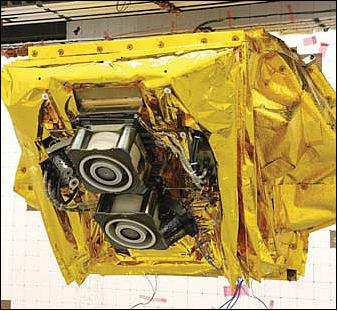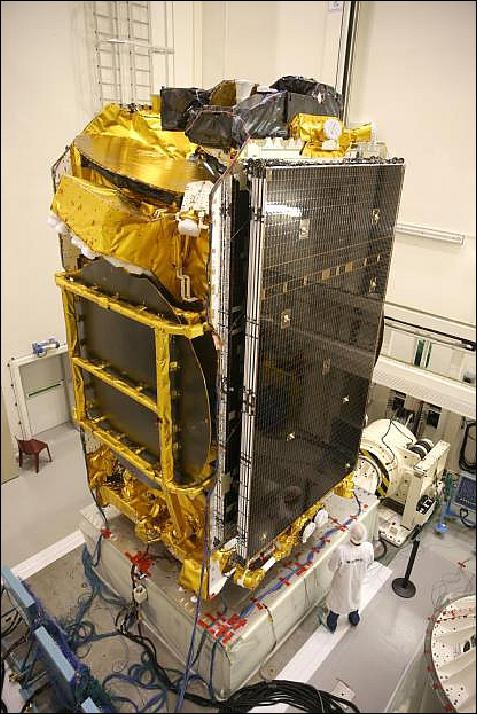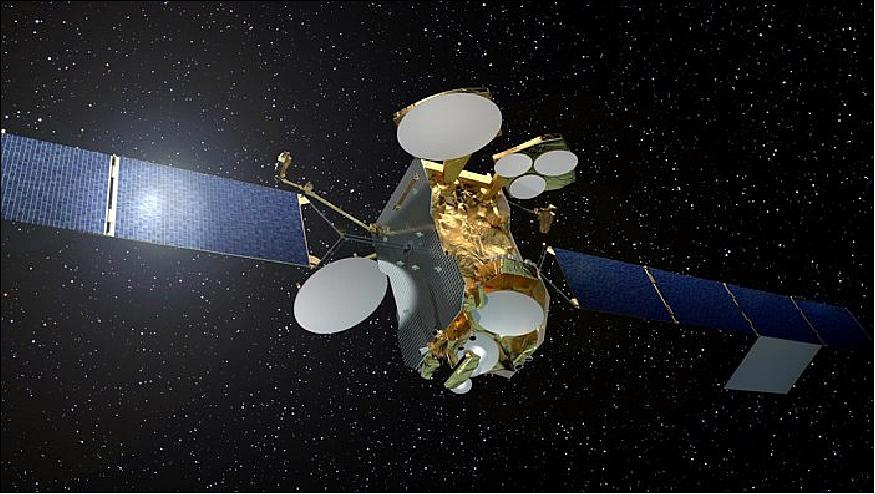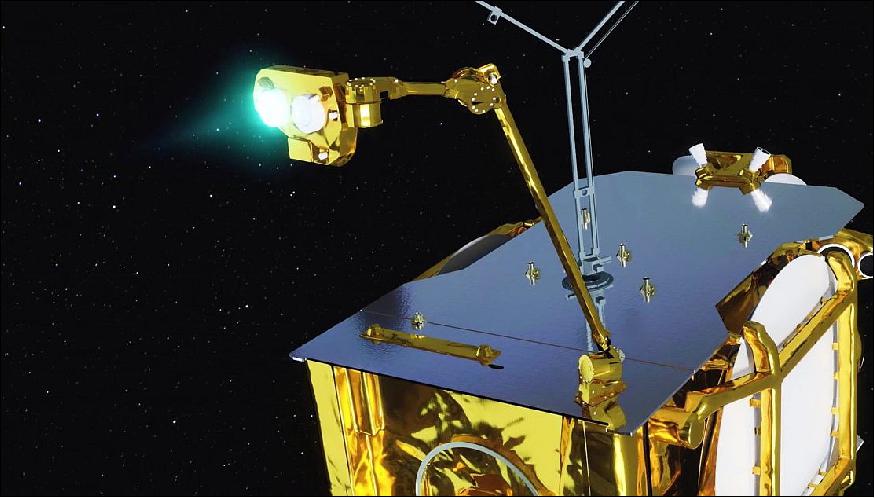Eutelsat 172B
Non-EO
Operational (nominal)
Eutelsat
Communications
Quick facts
Overview
| Mission type | Non-EO |
| Agency | Eutelsat |
| Mission status | Operational (nominal) |
| Launch date | 01 Jun 2017 |
| CEOS EO Handbook | See Eutelsat 172B summary |
Eutelsat 172B
Spacecraft Launch Payload Mission Status References
Overview
Eutelsat 172B is a communications satellite featuring a C-band, a Ku-band and a high throughput payload and an all-electric orbital raising capability. The spacecraft was built by Airbus DS and is based on the highly reliable Eurostar E3000 platform, representing its latest EOR (Electric Orbit Raising) evolution. This version relies exclusively on electric propulsion for initial orbit raising and all on-station maneuvers, with the consequent reduction in mass enabling the satellite to be launched in the Ariane 5 lower position, resulting in lower launch costs.
In July 2014, Eutelsat communications, with HQs in Paris, awarded contracts to Airbus Defence and Space and to Arianespace, respectively, to build and launch the Eutelsat 172B satellite in 2017. 1)
Spacecraft
The satellite is based on the Eurostar E3000 platform of Airbus DS. The satellite combines electric power of 13 kW with a launch weight of only 3,500 kg. This highly innovative satellite will host three distinct payloads that will strengthen Eutelsat's capability to serving Asia-Pacific markets: a C-band payload, a regular Ku-band payload and a high throughput payload specifically designed for in-flight connectivity along Pacific air corridors.
Electric Orbit Raising (EOR)
The spacecraft will use Safran/Snecma PPS-5000 electric propulsion for initial orbit raising and all on-orbit maneuvers. The satellite's in-orbit raising is expected to take approximately four months. The all-electric platform for the satellite was developed in collaboration with ESA and CNES under the framework of the Plan d'Investissements d'Avenir (PIA) program. It will include deployable robotic arms, which can be used for orientation of the satellite's electric propulsion thrusters and to control thrust direction and attitude.

Electric propulsion makes it possible to reduce the mass of satellites, leading to lower launch costs for a given mission and/or a more capable satellite for a given mass. Airbus Defence and Space has been using electric propulsion for station keeping for more than ten years, and is building the first large satellites using only electric propulsion for initial orbit raising. 2)
Most often, the thrusters powering satellites are, to put it simply, just miniature versions of the ones used on the launcher. Thrust is usually generated by expelling hot gas, resulting from the combustion produced in combining two chemicals, a fuel and an oxidizer. Chemical thrusters are powerful but consume a lot of fuel: for satellites using chemical propulsion, a large amount of the launch mass is propellant.
In contrast, electric thrusters are less ‘mass-hungry' but have far lower thrust. EP (Electric Propulsion) replaces the chemicals usually used with a much smaller quantity of noble gas such as xenon, ejected at very high speed - the higher speed, the higher the efficiency (measured by the specific impulse Isp), the less mass is needed for a given maneuver or the accumulated change in velocity.
Masses: On a geo satellite using only chemical propulsion, and weighing six tonnes at launch, roughly two tons of propellant (fuel and oxidizer) are needed for initial orbit raising (three to five maneuvers performed in about one week) and 1 ton is needed for station keeping (small periodic maneuvers all along the 15+ years of mission). If one or both types of maneuver are performed using electric propulsion, less propellant is needed and accordingly, the satellite is lighter. The gain is significantly higher when both orbit raising and station keeping are done with electric propulsion, compared to when only station keeping uses electric propulsion.
Station keeping: Station keeping relates to the maneuvers needed to maintain the satellite within its assigned operational ‘box' in geostationary orbit (a kind of cube roughly 70 km on a side), counteracting gravitational effects and solar wind that tend to make it drifting away. - For this the satellite propulsion system generates small thrusts periodically, throughout the 15+ years of operations. The total energy needed for station keeping over the mission is roughly half the amount needed for initial orbit raising from a standard geo transfer orbit - where the satellite separates from the launcher.
Since the program's inception, Airbus Defence and Space has proposed electric (plasma) propulsion for station keeping as an option on its flagship Eurostar E3000 platform. Electric station keeping has been successfully operated in orbit for more than 10 years, with more than 25,000 hours of thruster firing accumulated by seven Eurostar satellites for operators Intelsat, Inmarsat, Eutelsat and Yahsat. Six more Eurostar E3000 models equipped with electric propulsion are in production, including the DirecTV 15 satellite to be launched in a few weeks. The Alphasat satellite based on the new high capacity European platform Alphabus is also equipped with electric propulsion for station keeping.
EOR (Electric Orbit Raising): Since initial orbit raising from GTO (GEO Transfer Orbit) to geostationary altitude demands by far the largest amount of energy from the satellite (about 12 to 15% of the total launch velocity), this is where electric propulsion has the largest mass saving potential. Its use, however, has been hindered by the low thrust produced by electric engines, typically 5000 times less powerful than liquid apogee engines. Small thrust is not a problem for station keeping, since orbit maintenance maneuvers can be long and smooth. But for station acquisition, it means a longer time before entry into operational service and for a commercial satellite, deferred revenues. High power electric propulsion systems also have a cost such that electric satellites are rather more expensive than their chemical counterparts. Finally, there are also some constraints related to the EOR phase (radiation, operations), the severity of which is commensurate with the duration.
This means that electric orbit raising pays off when the reduction in launch cost or additional mission capabilities more than compensate for the extra cost, deferred revenues and other constraints.
A key element then is the use of reliable solutions that keep overall system costs under control and reduce the duration of orbit raising. After several years' development to implement EOR on its Eurostar offering, building on a sound and proven product line and making it evolve gradually, Airbus Defence and Space successfully introduced the new Eurostar E3000EOR version (in short, E3000e) to the market in 2014 with two contracts from two major operators, SES and Eutelsat. These two contracts exemplify different aspects of the benefits electric propulsion can bring to satellite operators, in different segments of the market. With the reduction in launch mass full electric orbit raising allows, extremely powerful missions can be offered with payloads of typically 15kW/1500 kg for 5-6 ton class satellites (i.e. including the Ariane upper position), or regular missions above 10 kW with lower launch costs (incl. Ariane lower position or Falcon 9).
Time to orbit: Many of the proposed electric propulsion systems require times to GEO of more than six months due to low thrust. In most circumstances however, six months appear the longest acceptable time for commercial satellites, and two-three months to target. As the total energy required is proportional to the satellite mass for a given change in velocity, raising large satellites means even more time, so EOR has initially been proposed for relatively small satellites, so as not to exceed acceptable time to orbit.
To achieve faster EOR, more powerful thrusters, or more numerous thrusters are used, as long as the cost remains reasonable and the total power power requirements do not require solar arrays, etc. to be oversized with regard to the communication mission needs. Another option is to consider a mix of chemical propulsion for the first part of orbit raising, followed by EOR for the remaining part (orbit topping) a compromise between mass reduction and orbit raising duration, the cost being a double propulsion system.
Airbus DS currently uses high thrust HETs (Hall Effect Thrusters), and an increase of thrust with new engines is observed completing their development. HET engines of the latest generation such as Fakel SPT140D or Snecma PPS5000 have three to four times the thrust of current engines such as Fakel SPT100 or Snecma PPS1350, while their efficiency (specific impulse, Isp) is improved by 20%.
Depending on the initial orbit (in turn, depending on launcher/satellite matching) Airbus DS can currently propose full EOR in three-five months. In other words, high thrust engines make it possible to offer an acceptable EOR duration, even for large and powerful missions.

Development Status
• March 15, 2017: EUTELSAT 172B, the first high power all-electric telecommunications satellite, is now ready for shipment on 20 March from the Airbus satellite assembly facility in Toulouse to Kourou, French Guiana for Eutelsat, one of the world's leading satellite operators. The satellite will be launched into orbit on an Ariane 5, and will provide enhanced telecommunications, in-flight broadband and broadcast services for the Asia-Pacific region. 3) 4)
- "Using electric propulsion for initial orbit raising and all on-station maneuvers has led to a substantial weight reduction, enabling the satellite to be launched in the Ariane 5 lower position and offering more competitive launch costs," said Arnaud de Rosnay, Head of Telecommunications Satellites at Airbus DS.
• January 23, 2017: Construction of Eutelsat 172B, the first high-power all-electric telecommunications satellite built in Europe, is now complete at the Airbus satellite assembly facilities in Toulouse. The fully fledged satellite for Eutelsat is now undergoing final testing before it is sent to Kourou, French Guiana, for an Ariane 5 launch scheduled in April. 5)
Launch
Eutelsat 172B along with ViaSat-2 were launched on June 1, 2017 (23:45 UTC) on an Ariane-5 ECA vehicle from Kourou, French Guiana. The satellite launch operations were provided by Arianespace. ViaSat-2, with a launch mass of 6,418 kg, was the first to be released after about 29 minutes. The 3,551 kg Eutelsat-172B was released 12 minutes later. 6) 7)
• ViaSat-2, owned and operated by ViaSat, will provide extended broadband coverage to North and Central America, the Caribbean, northern South America, and the aeronautical and maritime routes in the Atlantic Ocean between North America and Europe. The satellite has a design life of more than 14 years.
• Eutelsat-172B, an all-electric satellite built in Europe for Eutelsat, will provide telecommunications and broadcasting services as well as inflight broadband and maritime connectivity to the Asia–Pacific region. The satellite has a design life of more than 15 years.
The payload mass for this launch was 10,865 kg. The satellites totalled about 9,969 kg, with payload adapters and carrying structures making up the rest.
Orbit: Eutelsat 172B will be placed into GTO (Geosynchronous Transfer Orbit) and eventually placed into GEO at 172ºE longitude to provide continuity and expansion capacity at this prime gateway for satellite services in the Asia-Pacific region. 8)

Mission Status
• November 23, 2017: Eutelsat Communications' all-electric Eutelsat 172B satellite has entered full commercial service and is now offering greatly enhanced flexibility, power and connectivity for users in a vast region stretching from the West coast of the Americas to Asia, Oceania and across the Pacific. 9)
- The transfer of services to Eutelsat 172B from Eutelsat 172A was completed seamlessly in a series of overnight maneuvers, releasing EUTELSAT 172A for an alternative orbital position to serve customers in the Asia-Pacific (APAC) region.
- In addition to the HTS (High Throughput) payload, EUTELSAT 172B significantly increases regular bandwidth at the 172° East position, with C-band capacity as well as flexible Ku-band capacity spread across five interconnecting widebeam service areas. Beyond maritime, video, enterprise, cellular backhaul and government services, the Ku-band capacity will serve as an overlay to economically deliver live television to passengers in flight.
• October 17, 2017: Europe's first all-electric telecom satellite has reached its final working orbit above the Pacific Ocean. Eutelsat-172B, built for Eutelsat by Airbus DS, carries new technologies developed through ESA-led projects, including fully articulated thruster arms. 10)
- The satellite relied entirely on electric thrusters to climb from its initial orbit into its planned slot over the equator some 35 800 km up, and is now using them to hold position. "Electric propulsion is at least an order of magnitude more efficient than standard chemical propulsion for satellites," explains ESA electric propulsion specialist Jose Gonzalez Del Amo. "By electrically charging propellant and accelerating it using electrical power from solar arrays, much more energy is squeezed out of each breath of gaseous propellant."
- "This opens up the option of flying lighter satellites because they can fly on smaller launchers. Or a greater percentage of the same mass can be dedicated to the revenue-earning payload in place of bulky propellant tanks. The main trade-off is that all-electric satellites take much longer to reach their final orbit because electric propulsion provides low thrust, firing continuously to accelerate gradually over time."
- Eutelsat-172B – the first to fly of six Eurostar E3000 all-electric platforms sold so far to telecom companies by Airbus – reached its working orbit some four months after its 2 June launch.

- Already a commercial success, this platform includes several innovations developed through ESA's long-running ARTES (Advanced Research in Telecommunications Systems) program, as well as the equivalent Plan d'Investissements d'Avenir program of France's CNES space agency.
- "All-electric telecom satellites have been in service globally since 2015, but Eurostar E3000 has a novel addition: a pair of 3 m-long three-jointed arms carrying thrusters on the end," explains ESA structural engineer Mario Toso. "Instead of having different thrusters embedded at corners of the satellite, the twin arms can be moved freely about its body. One big advantage is that the thrusters can always be aligned precisely with the satellite's center of gravity for orbit raising and stationkeeping – saving propellant to elongate mission life. And this flexibility means the thrusts can be choreographed around antennas and solar wings which might otherwise be struck by thruster plumes."
- A second project developed the thrusters' power processing unit – the interface between them and the rest of the satellite's power system.
- "The thrusters operate on a high voltage, receiving lower voltage inputs from the rest of the satellite," says ESA power systems engineer Michail Tourloukis. "This unit helps to ensure that electrical noise from their operation does not come back inside the satellite."
- Improved versions of E3000's thruster arms and power unit are now included in Airbus's next-generation satellite platform, Eurostar Neo, which they are developing under ESA's Neosat program.
- ESA's Giorgio Saccoccia comments: "This game-changing electric propulsion on European commercial and scientific satellites is the result of more than two decades of development by ESA, in strong collaboration with national agencies and European companies. The achievement of Eutelsat-172B is a reward for the role that ESA has played with our partners, boosting the competitiveness of European products."
• October 11, 2017: Following completion of the payload in-orbit tests and drift to its operational location led by the Eutelsat team, the satellite is scheduled to enter commercial service in November to provide enhanced telecommunications, in-flight broadband and broadcast services for the Asia-Pacific region. Its life span is expected to exceed 15 years thanks to electric propulsion for in-orbit raising and station-keeping. 11)
- This fully electric satellite has made it to the record books with its speedy movement into geostationary orbit. "We are the first company to demonstrate full electric propulsion for satellites of this size and capacity, enabling their launch in the most cost-efficient manner. Furthermore with our system design, operation strategy and the plasma thruster technology we implement, we have completed the fastest electric orbit raising ever from transfer to geostationary orbit, which will allow Eutelsat to put their electric satellite into service in record time," said Nicolas Chamussy, Head of Space Systems at Airbus.
- EUTELSAT 172B combines 13 kW of payload power with a launch mass of only 3,550 kg, due to the latest EOR (Electric Orbit Raising) version of Airbus' Eurostar E3000 platform.
- The EOR success and reaching orbit in record time was made possible by two Airbus innovations:
1) A pair of deployable robotic arms which orientate the satellite's electric propulsion thrusters, and control thrust direction and attitude during different phases of the mission.
2) The WALIS (Wide Angle Localization Integrated System) network of ground stations around the world, developed by Airbus, which has enabled engineers to control orbit raising operations until the satellite reached geostationary orbit.
- The development of Airbus' Eurostar all-electric satellites has been supported by ESA and space agencies of European countries, in particular in France by the CNES in the framework of the PIA program (Plan d'Investissements d'Avenir) and in the UK by the UK Space Agency.
• June 9, 2017: Launched on June 1 by an Ariane 5 rocket, the Eutelsat 172B satellite has entered a new phase of its journey in space with the initiation of the ascent to geostationary orbit. The first European high power electric satellite, built by Airbus, will take approximately four months to complete the climb to 172° East, monitored by Eutelsat and Airbus from Toulouse using a dedicated network of stations located around the planet. Eutelsat's new satellite is scheduled to enter into service in the fourth quarter of this year. 12)
- Since launch, Eutelsat 172B has undergone a series of critical maneuvers that include positioning of electric propulsion motors attached to robotic arms in preparation for orbit-raising, and the full deployment of solar panels to generate power during this phase.
Communication Payload
The Eutelsat 172B satellite features C-band, regular Ku-band, and high throughput Ku-band payloads. The C-band payload includes 14 transponders, which will help in delivering increased power and broader coverage to augment service and expand new growth markets in South-East Asia.
The satellite will host three distinct payloads:
1) A C-band payload, which will deliver increased power and broader coverage to enhance the service provided today to existing customers via Eutelsat 172 A and tap into new growth markets in South East Asia. The C-band payload will include 14 transponders, which will help in delivering increased power and broader coverage to augment service and expand new growth markets in South-East Asia.
2) A regular Ku-band payload which will double the capacity at 172º East and connect to five improved service areas: North Pacific, North East Asia, South East Pacific, South West Pacific and South Pacific.
3) An innovative high throughput Ku-band payload specifically designed for in-flight broadband, which will feature multiple user spots optimized to serve densely-used Asian and trans-Pacific flight paths and interconnected to gateways. The high-throughput Ku-band payload with 11 transponders will provide in-flight broadband connectivity over the Pacific Ocean, delivering an overall throughput of 1.8 Gbit/s. It will feature multiple user spots optimized to serve densely used Asian and trans-Pacific flight paths and interconnected to gateways.
Panasonic Avionics Corporation has selected the Eutelsat 172B satellite as its platform for trans-Pacific and Asian in-flight broadband via live TV services for commercial airlines.
References
1) "Airbus Defence and Space to build EUTELSAT 172B, first European satellite to perform electric orbit raising," Airbus DS, Press Release, July 31, 2014, URL: https://airbusdefenceandspace.com/newsroom/news-and-features/airbus-defence
-and-space-to-build-eutelsat-172b-first-european-satellite-to-perform-electric-orbit-raising/
2) François Gaullier, "Electric Satellites - Lighter and Smarter," APSCC (Asia-Pacific Satellite Communication Council) Quarterly Newsletter, Q1 , 2015, URL: http://www.apscc.or.kr/upload/pdf/Q1%202015.pdf
3) "All-electric propulsion for orbit-raising and on-station maneuvers inaugurates significant mass savings on this class of mission," Airbus DS Press Release, March 15, 2017, URL: https://airbusdefenceandspace.com/newsroom/news-and-features/airbus-ships
-first-high-power-all-electric-eutelsat-172b-satellite-to-kourou-for-eutelsat/
4) "EUTELSAT 172B satellite: on the road to Kourou," Eutelsat Press Release, March 15, 2017, URL: https://web.archive.org/web/20170331200530/http://news.eutelsat.com/pressreleases/eutelsat-172b-satellite-on-the-road-to-kourou-1857558
5) "Airbus Defence and Space: First European-built all-electric satellite EUTELSAT 172B getting ready to fly," Airbus DS Press Release, Jan. 23, 2017, URL: https://airbusdefenceandspace.com/newsroom/news-and-features/airbus-defence-and-space-first-european
-built-all-electric-satellite-eutelsat-172b-getting-ready-to-fly/
6) "Ariane 5 launches its heaviest telecom payload," ESA, June 2, 2017, URL: http://m.esa.int/Our_Activities/Space_Transportation
/Ariane_5_launches_its_heaviest_telecom_payload
7) "Success for Airbus Safran Launchers and Arianespace as They Celebrate Third Launch," Satnews Daily, June 1, 2017, URL: http://www.satnews.com/story.php?number=6344394
8) "New high-capacity triple mission satellite for expansion in the Asia-Pacific region," Eutelsat brochure, 2016, URL: http://www.eutelsat.com/files/contributed/news/media
_library/brochures/EUTELSAT_SATELLITE_E172B.pdf
9) "The Eutelsat-172B Satellite Enters Full Commercial Service," Satnews Daily, 23 Nov. 2017, URL: http://www.satnews.com/story.php?number=1658138365
10) "ESA role in Europe's first all-electric telecom satellite," ESA, 17 Oct. 2017, URL: http://m.esa.int/Our_Activities/Space_Engineering_Technology
/ESA_role_in_Europe_s_first_all-electric_telecom_satellite
11) "Airbus' Electric EUTELSAT 172B Super Speedy Satellite Makes Geostationary Orbit in Record Time," Satnews Daily, Oct. 11, 2017, URL: http://www.satnews.com/story.php?number=643310644
12) "Eutelsat 172B satellite begins ascent to geo, Eutelsat Press Release, June 9, 2017, URL: https://web.archive.org/web/20170619003311/http://news.eutelsat.com/pressreleases/eutelsat-172b-satellite-begins-ascent-to-geo-2009381
The information compiled and edited in this article was provided by Herbert J. Kramer from his documentation of: "Observation of the Earth and Its Environment: Survey of Missions and Sensors" (Springer Verlag) as well as many other sources after the publication of the 4th edition in 2002. - Comments and corrections to this article are always welcome for further updates (eoportal@symbios.space).
Spacecraft Launch Payload Mission Status References Back to Top